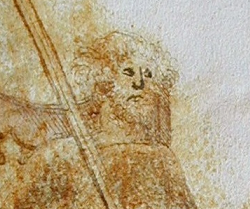|
|
You are not currently logged in. Are you accessing the unsecure (http) portal? Click here to switch to the secure portal. |
Wiktenauer:Main page/Featured
| Sigmund ain Ringeck | |
|---|---|
 | |
| Period | 15th century |
| Occupation | Fencing master |
| Patron | Albrecht, Duke of Bavaria |
| Movement | Fellowship of Liechtenauer |
| Influences | Johannes Liechtenauer |
| Influenced | |
| Genres | Fencing manual |
| Language | Early New High German |
| Archetype(s) | Hypothetical |
| Principal manuscript(s) |
|
| Manuscript(s) |
|
| First printed english edition |
Tobler, 2001 |
| Concordance by | Michael Chidester |
Sigmund ain Ringeck (Ainring, Amring, Einring, Sigmund Schining) was a 15th century German fencing master. While the meaning of the name "Schining" (assigned him by Hans Medel) is uncertain, the surname "Ainringck" may indicate that he came from the village of Ainring on the current German/Austrian border. He is named in the text as Schirmaister to Albrecht, Count Palatine of Rhine and Duke of Bavaria. This may signify Schirrmeister, a logistical officer charged with overseeing the wagons and horse-drawn artillery pieces, or potentially Schirmmeister, a title used by lower-class itinerant fencing masters in the Medieval period. Apart from his service to the duke, the only thing that can be determined about his life is that he was connected in some way to the tradition of Johannes Liechtenauer—his name was included by Paulus Kal in his roll of members of the Fellowship of Liechtenauer in ca. 1470.
The identity of Ringeck's patron remains unclear, as four men named Albrecht ruled Bavaria during the fifteenth century; assuming that Ringeck was a personal student of Johannes Liechtenauer further narrows the list down to just two. If the MS 3227a is correctly dated to 1389, then Liechtenauer was a 14th century master and Ringeck's patron was Albrecht Ⅰ, who reigned from 1353 to 1404. If, on the other hand, Liechtenauer was an early 15th century master (an associate of H. Beringer) and the Fellowship of Liechtenauer was assembled to fight in the Hussite Wars of the 1420s and 30s, then Ringeck's patron would have been Albrecht Ⅲ, who carried the title from 1438 to 1460. Albrecht Ⅳ claimed the title in 1460 and thus also could have been Ringeck's patron; this would probably signify that Ringeck was not a direct student of Liechtenauer at all, but a later inheritor of the tradition. That said, Albrecht Ⅳ lived until 1508 and so the Dresden, Glasgow, and Salzburg manuscripts were likely created during his reign.
Ringeck is often erroneously credited as the author of the MS Dresd.C.487. Ringeck was indeed the author of one of the core texts, a complete gloss of Liechtenauer's Recital on unarmored long sword fencing. However, the remainder of the manuscript contains an assortment of treatises by several different masters in the tradition, and it is currently thought to have been composed in the early 16th century (putting it after the master's presumed lifetime). Regardless, the fact that he was one of only a few known authors of a gloss of the Recital makes Ringeck one of the most important masters of the Liechtenauer tradition.
Stemma
While only one treatise bears Ringeck's name, a gloss of Liechtenauer's Recital on the long sword, he is often considered to be the author of the glosses of the short sword and mounted verses as well. The latter are associated with Ringeck largely due to the previously mentioned misattribution of the entire MS Dresd.C.487 (Dresden), but this is not an entirely unreasonable attribution to make considering the long sword is always accompanied by one or both of the others. All three seem to be based on the gloss of the anonymous author known as "pseudo-Peter von Danzig", which is attested from the 1450s; it is also possible that Ringeck and pseudo-Danzig were the same person, and the gloss attributed to Ringeck is simply the only branch of the larger stemma that retained its author's name.
(Read more…)
- Recently Featured:
- Andre Paurenfeyndt – Pseudo-Peter von Danzig – Ridolfo Capo Ferro da Cagli – Antonio Manciolino – Nicoletto Giganti
